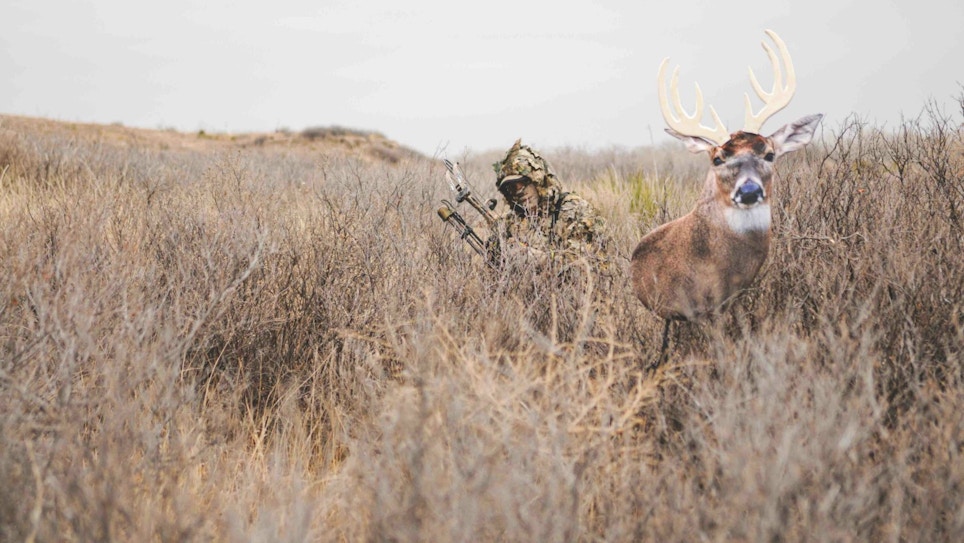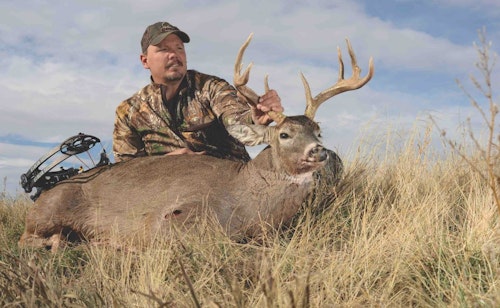
Open-country bucks are well-versed at traveling without being seen in their mostly treeless habitat. A knowledgeable bowhunter can take advantage of the same cover, too.
For nearly a week I hunted the ribbon of cottonwoods and willows that dotted the eastern Colorado creek-bottom and had little to show for it. With well over a mile of public access and no hunting pressure to contend with, I was surprised deer activity had been so thin. With just a few days left in the season and mid-November fast approaching, I had to switch gears if I wanted to make something happen.
The following morning found me focused on the same ribbon of trees, but this time my view would be from the rocky ridges that guarded the creek. As the sun began to creep up from the east, I settled into a cluster of pinion-junipers and put the glass to work. As I looked over every nook and cranny, movement caught my attention from nearly every direction. Whitetails, mule deer and even a handful of elk off in the distance kept me entertained, and the longer I watched, the more I beat myself up for spending so much time in my traditional treestand setup.
For more than an hour I watched as deer moved toward their bedding areas. Although some bucks did head to the security that the ribbon of trees provided along the creek, it seemed most preferred the coulees and draws around it.
As the sun’s rays melted away the morning’s coolness, two particular bucks kept me glued to my binocular. One was a handsome 4x3 that carried mass and long main beams, and the other a symmetrical 5x5. As they milled about at opposite ends of a large meadow that was flanked on two sides by open hillsides and draws, I studied every move they made. The 10-pointer slipped from view without giving me the ability to establish his resting place, but the heavy 7-pointer took refuge in a shaded grassy draw, and I knew exactly where he landed.
By mid-morning I was set. With a fairly strong wind and the buck bedded for the day, it was time to slip close. Knowing he bedded against the shaded side of the grassy draw, I eased above it and meticulously worked its edge. Crawling on all fours to keep my profile low, I peeked over every 30 to 40 yards, glassed the area intently, then moved deeper. As I neared the end of the shaded draw, I caught the flash of antlers above the grass.
Although he was bedded close, 70 yards is a no-way shot on a whitetail. My only option was to try and come in from behind, close the distance and then wait for him to stand. Fifteen minutes soon turned into 30, and 30 turned into a couple hours. Then, when the sun hit its pinnacle, the 7-pointer finally stood. In an instant I came to full draw; when I steadied the pin, I touched the release.
In disbelief, I watched my arrow fly a little wide. Needless to say, he bounded away in a flash, but the open-country experience added another tool to my whitetail kit that I have used many times since.
Overcome Open Country
I’ll be the first to admit it: Bowhunting open-country whitetails intimidated me initially. Being used to woodlots, treestand hunting always seemed to strike a chord. However, as opportunities closer to home materialized in eastern Colorado and southwest Oklahoma, I found myself having to adapt and change my methods. That’s not to say my handful of hang-ons are collecting dust. Far from it. But I have learned that a strategically placed blind, an open-country stalk in uneven terrain, and even calls and decoys can be effective. In fact, my wall has more than one whitetail from these vast open-country regions, and over time I have found these haunts to be just as good as those east of the Mississippi.
One of the main reasons I have chosen this country is the lack of hunting pressure open-country whitetails usually see. Fact is, whitetail hunters just don’t like this landscape, preferring the elevation provided by a tree to a ridge overlooking a brushy draw when whitetails are concerned. It’s rare that I see another bowhunter stalking a bedded whitetail buck or nestled in a make-shift ground blind in these wide-open spaces. When I do see one, they are usually driving down a dirt road wondering why they even tried in the first place.
Another reason I have found bowhunting comfort in such country is it provides more cover than most might think. Whether it’s tall CRP grass, a thick hedge row, isolated brushy draw or natural terrain, I have learned many bucks prefer them. For one, public land deer learn quickly where most of the hunters are not. Tall grass or a brush-choked draw provides more than concealment to these open-country masters, thermal cover on those blistery days, and escape routes to swallow them up are always good uses as well. It seemed odd to me at first that some bucks would prefer waist-high grass or a cut milo field over the seclusion of a hardwood thicket, but when I saw them disappear before my eyes, it was easy to understand. More than once I have tried sneaking close to their bedding lair only to see them streak across the treeless landscape untouched.
Lastly, being attached to a tree throughout the deer season shrinks your opportunities in these more open locations. Don’t get me wrong, a well-placed treestand in sparsely treed country can be effective, but in open country you have to be ready to move in the blink of an eye. Several falls ago, while nestled in an Oklahoma cottonwood, a buck came out of a thicket 400 yards away and bedded in a heavy patch of waist-high grass in the middle of a pasture. He was only 80 yards away, and I used every tool at my disposal to get him to respond, but nothing worked. I could tell by how his antlers turned that he could clearly hear me, but he apparently had other plans. Wanting to create an opportunity, I climbed down and eased closer to his position. When he stood as the evening shadows lengthened, my arrow slipped through his chest.

Tools of the Trade
Needless to say, binoculars are indispensable in open country, and I believe few whitetail hunters tap into their potential. Living out West forces you to use them to not only find game in vast country, but eliminate areas as well. In fact, a good western hunter will often use his binocular and/or spotting scope as much or even more than actually stalking. This same tactic can be used in open-country situations as well. More than any other big game animal, whitetails are extremely patternable, especially during early season. Capitalizing on this in open country can pay dividends. Although patterns are less defined during the rut, bucks are on the move and finding one moving through an open-country pinch point is a bonus.
While glassing, look for details such as fence crossings, fence rows, natural terrain pinch points and particular drainages or ridges deer tend to use. These can be ideal locations for a blind if deer activity is strong, or simply areas to keep a close eye on for a sneak.
Using a decoy and call in open country can also be effective, and for the bowhunter on the move it’s hard to beat the portable two-dimensional decoys such as Heads Up, Montana and the new Ultimate Predator shoot-though decoy. These models are extremely lightweight, packable and can be handheld, attached to your bow or clipped to brush. I’ve had several bucks fooled by such setups, and it can get western pretty quick when you’re looking at a slobbering buck eye to eye at 20 yards.
Ideally, the key to using a deer decoy in open country is slipping within 80 yards or so of the bedded buck, pop up the decoy and then grunt him into shooting range. In my experience, bucks don’t like surprises, so getting much closer could possibly send him packing. On the other hand, getting much farther away would give the buck a better opportunity to circle downwind. In most cases, the buck is going to do one of three things: get out of there, do nothing, or come in. Decoys will also buy you some time, giving you a few seconds longer to draw your bow and settle the sight pin.
The buck decoy seems to work extremely well during the early phases of the whitetail rut. The decoyed buck is either going to think the decoy in a rival buck, or that he has a hot doe pinned down. Doe decoys seems to work better earlier in the archery season.
Sidebar: Open-Country Whitetail Equipment
Engineered to the demands of world champion archer Levi Morgan is the new #261 broadhead from Swhacker, which features a chisel tip design coupled with the unique arched blades that reduces resistance as it plows through game. Its reinforced ribbed ferrule delivers up to 20 percent greater strength and rigidity than other Swhacker models. Upon impact the sharp 1-inch wing blades initially cut through the hide to start the process and then swing the primary blades into place to deliver a 2-inch wound channel.
Adding to the already impressive lineup in Bushnell’s Forge series binoculars is a new 15X56 optical powerhouse. Utilizing ED prime glass with Ultra-Wide Band Coating to deliver brightness, the Forge series provides ultra-clear images in low-light conditions. The DiElectric and PC-3 phase coatings on each prism enhance resolution and contrast while the EXO barrier protective lens coating repels water, oil, dust and debris from the exterior lens surfaces, even in deteriorating weather conditions.
The IQ Define from IQ Bowsights features a laser rangefinder incorporated into the side of the sight housing that provides range readings throughout the shot cycle. Simply activate the rangefinder with a grip-mounted button and a blue LED is displayed in the corner of the sight housing revealing the yardage of your target. With five pins to choose from, you are quickly able to pick the right spot to deliver a lethal shot. The Define also boasts second- and third-axis adjustment, tool-free locking knobs, .019-inch pins with four brightness settings, and tool-free adjustments for windage and elevation.
Built for speed and long-range accuracy, the new ultra-light Airstrike from Gold Tip is ideal open-country ammo for the archer. With an extreme front-of-center design and built with high-modulus carbon, the micro-diameter Airstrike penetrates deep, is less affected by crosswinds, and features an exclusive Dyna-Slick coating that makes for easy arrow removal from targets.






